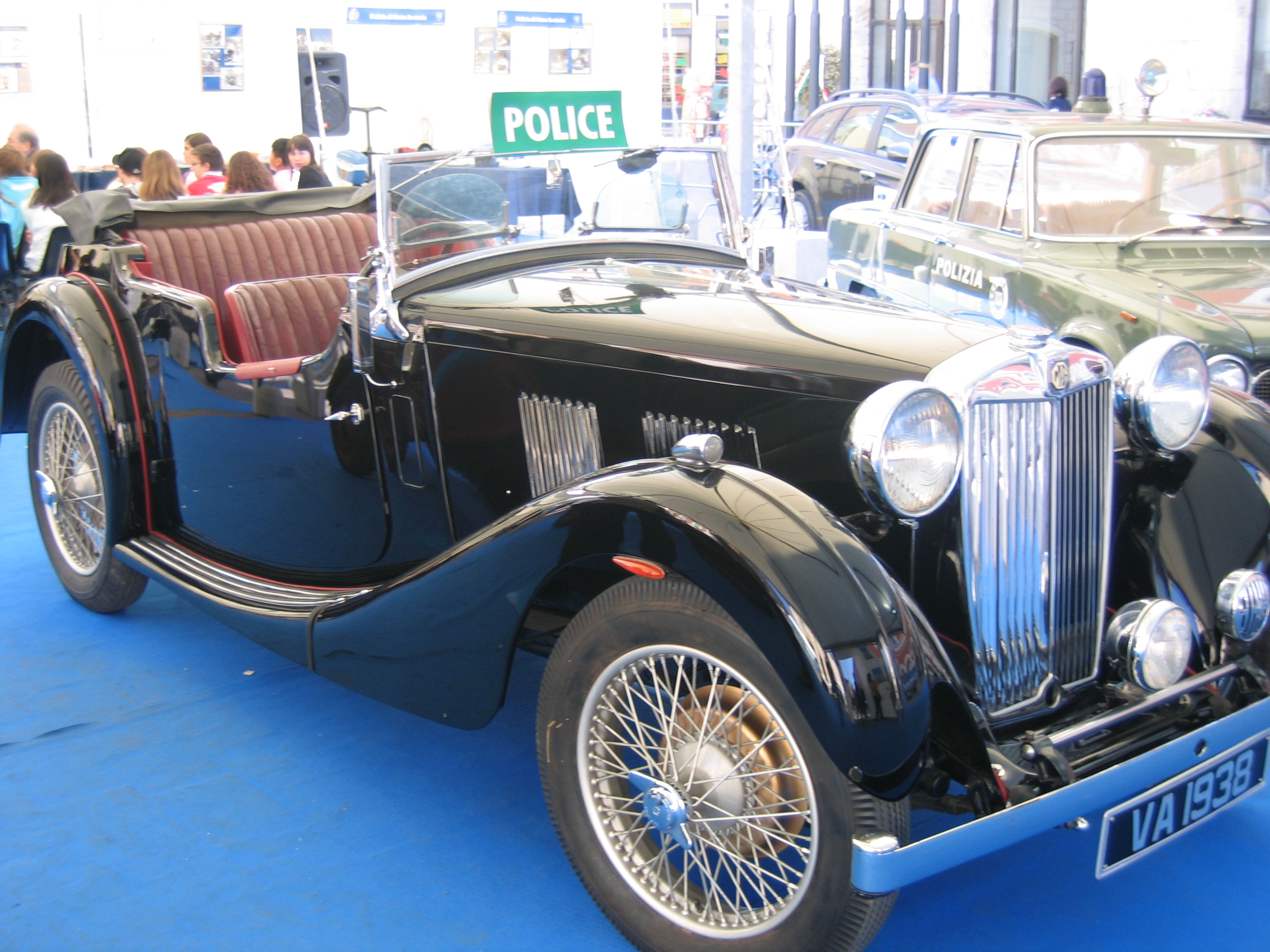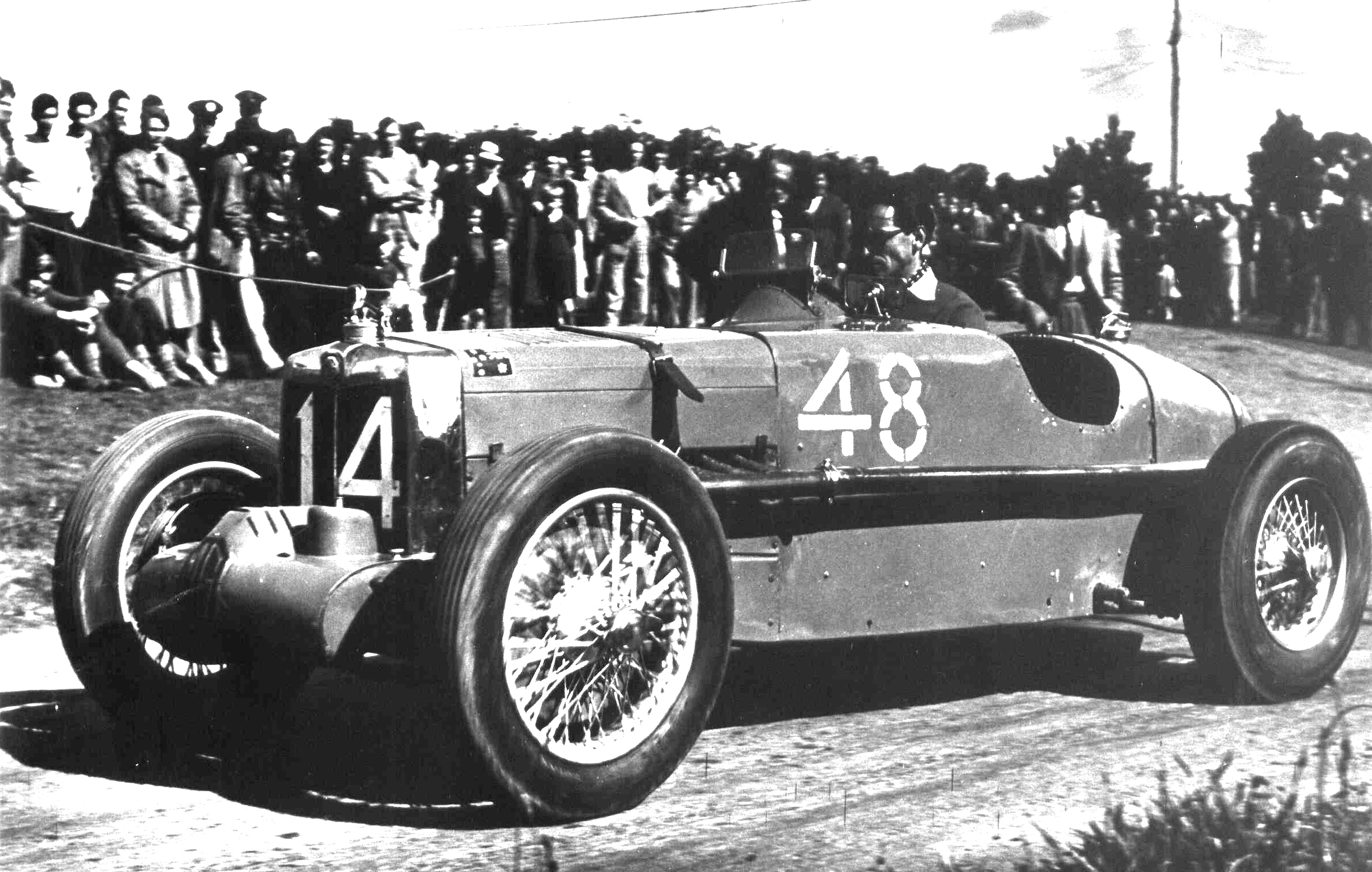|
MG KN
The MG KN Magnette is a coupé that was produced by MG between 1933 and 1934 and was designed to use up surplus bodies made for the unsold MG K-type saloons. These bodies were fitted to the K1 chassis but had the more powerful MG N-type The MG N-type Magnette is a sports car that was produced by MG from October 1934 to 1936. The car was developed from the K-Type and L-Type but had a new chassis that broke away in design from the simple ladder type used on the earlier cars of ... 1271 cc engine. The body had no pillar between the front and rear doors. The front doors were hinged at the windscreen end and closed against the rear doors. To give the impression of being a two-door coupé the rear doors had no external handles. The absence of the central pillar affected the structure of the body and often caused problems. A sunshine roof was fitted. The 56 bhp engine would take the car to 78 mph. A variation was sold by University Motors, the London MG dealer ... [...More Info...] [...Related Items...] OR: [Wikipedia] [Google] [Baidu] |
MG (car)
MG is a British automotive marque founded by Cecil Kimber in the 1920s, and M.G. Car Company Limited was the British sports car manufacturer that made the marque famous. Best known for its open two-seater sports cars, MG also produced Sedan (car), saloons and coupés, with engines up to three litres in size and 3.5L in the case of the MGB GT V8. The marque is now owned by Chinese state-owned automaker SAIC Motor, SAIC Motor Corporation Limited. MG cars had their roots in a 1920s sales promotion sideline of Morris Garages, a retail sales and service centre in Oxford belonging to William Morris, 1st Viscount Nuffield, William Morris. The business's manager, Cecil Kimber, modified standard production Morris Oxfords and added ''MG Super Sports'' to the plate at the nose of the car. A separate M.G. Car Company Limited was incorporated in July 1930. It remained Morris's personal property until 1 July 1935, when he sold it to his holding company, Morris Motors, Morris Motors Limited ... [...More Info...] [...Related Items...] OR: [Wikipedia] [Google] [Baidu] |
MG VA
The MG VA, or MG 1½-litre as it was originally marketed, is a motor car that was produced by MG between February 1937 and September 1939 and was the smallest of the three sports saloons they produced in the late 1930s, the others being the SA and WA. The car used a tuned version of the push-rod, overhead valve four-cylinder Morris TPBG type engine that was also fitted to the Wolseley 12/48 and Morris Twelve series III. The MG version had twin SU carburettors and developed at 4500 rpm. Drive was to the live rear axle via a four-speed manual gearbox with synchromesh on the top three ratios, though on some early cars it was only on the top two speeds. 19-inch wire wheels were fitted, and the drum brakes were hydraulically operated using a Lockheed system. In-built hydraulic jacks were standard. Suspension was by half-elliptic springs all round with a live rear axle and beam front axle. Luvax shock absorbers were fitted, the rear ones adjustable from the dashboard. B ... [...More Info...] [...Related Items...] OR: [Wikipedia] [Google] [Baidu] |
Straight-6
The straight-six engine (also referred to as an inline-six engine; abbreviated I6 or L6) is a piston engine with six cylinders arranged in a straight line along the crankshaft. A straight-six engine has perfect primary and secondary engine balance, resulting in fewer vibrations than other designs of six or less cylinders. Until the mid-20th century, the straight-six layout was the most common design for engines with six cylinders. However, V6 engines became more common from the 1960s and by the 2000s most straight-six engines had been replaced by V6 engines. An exception to this trend is BMW which has produced automotive straight-six engines from 1933 to the present day. Characteristics In terms of packaging, straight-six engines are almost always narrower than a V6 engine or V8 engine, but longer than straight-four engines, V6s, and most V8s. Straight-six engines are typically produced in displacements ranging from , however engines ranging in size from the Benelli 750 ... [...More Info...] [...Related Items...] OR: [Wikipedia] [Google] [Baidu] |
Manual Transmission
A manual transmission (MT), also known as manual gearbox, standard transmission (in Canada, the United Kingdom, and the United States), or stick shift (in the United States), is a multi-speed motor vehicle transmission (mechanics), transmission system, where gear changes require the driver to manually select the gears by operating a gear stick and clutch (which is usually a foot pedal for cars or a hand lever for motorcycles). Early automobiles used ''sliding-mesh'' manual transmissions with up to three forward gear ratios. Since the 1950s, ''constant-mesh'' manual transmissions have become increasingly commonplace and the number of forward ratios has increased to 5-speed and 6-speed manual transmissions for current vehicles. The alternative to a manual transmission is an automatic transmission; common types of automatic transmissions are the Automatic transmission#Hydraulic automatic transmissions, hydraulic automatic transmission (AT), and the continuously variable transmissio ... [...More Info...] [...Related Items...] OR: [Wikipedia] [Google] [Baidu] |
Coupé
A coupe or coupé (, ) is a passenger car with a sloping or truncated rear roofline and two doors. The term ''coupé'' was first applied to horse-drawn carriages for two passengers without rear-facing seats. It comes from the French past participle of ''couper'', "cut". __TOC__ Etymology and pronunciation () is based on the past participle of the French verb ("to cut") and thus indicates a car which has been "cut" or made shorter than standard. It was first applied to horse-drawn carriages for two passengers without rear-facing seats. These or ("clipped carriages") were eventually clipped to .. There are two common pronunciations in English: * () – the anglicized version of the French pronunciation of ''coupé''. * () – as a spelling pronunciation when the word is written without an accent. This is the usual pronunciation and spelling in the United States, with the pronunciation entering American vernacular no later than 1936 and featuring in the Beach Boys' hi ... [...More Info...] [...Related Items...] OR: [Wikipedia] [Google] [Baidu] |
MG K-type
The MG K-type Magnette is a motor car produced in the United Kingdom by MG from October 1932 to 1934. Launched at the 1932 London Motor Show, the K-Type replaced the F-Type Magna but having at first a slightly smaller capacity engine it took the name Magnette. The chassis was similar to the Magna but strengthened and had the track increased by 6 inches (150 mm) to 48 inches (1200 mm) and was available in two lengths with a wheelbase of either 94 inches (2388 mm) or 108 inches (2743 mm). The steering was modified with a patented divided track rod which was claimed to reduce kick back at the steering wheel. The brakes were cable operated with 13-inch (330 mm) drums made of " Elektron", a light magnesium alloy, with shrunk in steel liners. Suspension by half-elliptic springs and Hartford friction shock absorbers all round with rigid front and rear axles. Wire wheels with 4.75 x 19 tyres and centre lock fixing were used. The engines wer ... [...More Info...] [...Related Items...] OR: [Wikipedia] [Google] [Baidu] |
MG N-type
The MG N-type Magnette is a sports car that was produced by MG from October 1934 to 1936. The car was developed from the K-Type and L-Type but had a new chassis that broke away in design from the simple ladder type used on the earlier cars of the 1930s being wider at the rear than the front and with the body fitted to outriggers off the main frame. __TOC__ NA The engine was a further development of the 1271 cc 6-cylinder KD series overhead camshaft engine used in the K-type and originally used in the 1930 Wolseley Hornet. Modifications were made to the cylinder block and head and fitted with twin SU carburettors it produced at 5500 rpm, a near 25% improvement. Drive was to the rear wheels through a four-speed non-synchromesh gearbox. The car had a wheelbase of 96 inches (2439 mm) and a track of 45 inches (1143 mm). Semi elliptic leaf springs, wider and longer than those used on previous cars, were fitted all round and the body was mounted to the ch ... [...More Info...] [...Related Items...] OR: [Wikipedia] [Google] [Baidu] |
MG Vehicles
MG, Mg, or mg and variants may refer to: Organizations * MG Cars, an automotive marque of the now defunct MG Car Company * MG Motor, a present-day car manufacturing company *MG JW Automobile, a Pakistani automobile manufacturer * Champion Air (IATA code) * Matematička gimnazija, a school in Belgrade * Monte Generoso railway Arts and entertainment * MG, a character in ''The Perhapanauts'' comics * ''Match Game'', a television game show * Magilla Gorilla, a cartoon character Music * '' Main gauche'', "left hand" in piano playing * ''MG'' (Martin Gore album) * The M.G.'s, from the band Booker T. & the M.G.'s * ''The MG's'' (album), an album by the M.G.'s * MG Select, a house duo music production including George Jackson * M:G, real name Maribel Gonzalez, dance music singer Military * Machine gun (MG-), prefix for model designations, for example, "MG42" * Major general, a military rank * Medal for Gallantry, a military decoration Places * Madagascar (ISO 3166-1 country code MG ... [...More Info...] [...Related Items...] OR: [Wikipedia] [Google] [Baidu] |






